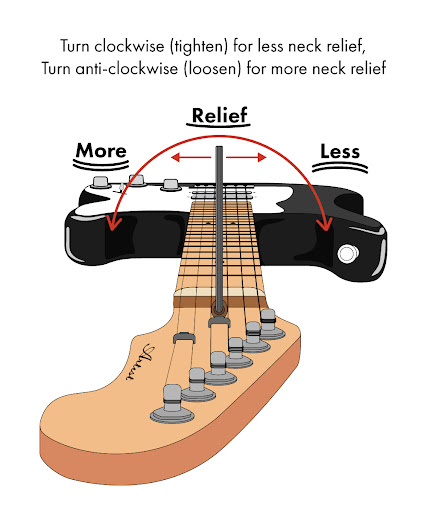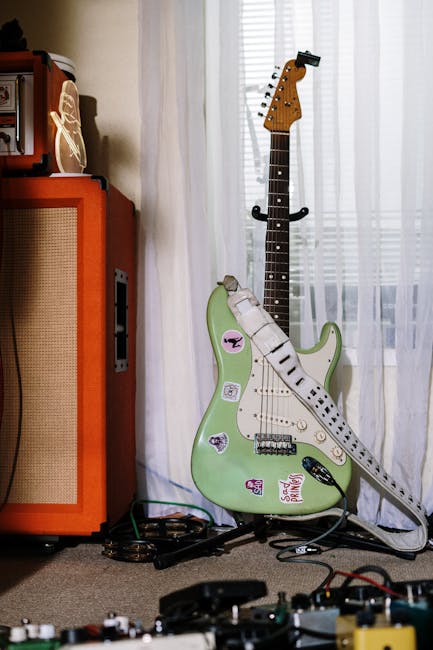Attention all rock gods and shredding enthusiasts! Are you tired of your trusty axe losing its edge and sounding more like a cat scratching a chalkboard than a powerhouse of musical energy? Fear not, because we’ve got the inside scoop on mastering guitar maintenance to keep your instrument in top performance shape. Say goodbye to wonky tuning pegs and pesky buzzing frets, and get ready to rock like never before with these crucial tips!
Contents
- 1 Understanding the Importance of Regular String Replacement
- 2 Identifying When It’s Time for a Truss Rod Adjustment
- 3 The Art of Fretboard Care and Maintenance
- 4 Achieving Optimal Sound: Bridge and Saddle Adjustments
- 5 Ensuring Electronics Functionality for Electric Guitars
- 6 Protecting Your Guitar: Humidity Control and Storage Insights
- 7 FAQs
- 8 Rock On and Keep Your Guitar Shredding!
Understanding the Importance of Regular String Replacement
So you may think that changing your strings only when they snap is totally fine, but let me tell you, that’s a big no-no! Regular string replacement is crucial for making sure your instrument sounds as sweet as a candy apple.
Think of your strings as the tires on a fancy sports car. They may not look worn out at first glance, but trust me, they can definitely affect your performance if left unchanged for too long. Plus, who doesn’t like that fresh string feeling?
By regularly replacing your strings, you’re not only improving your sound quality, but you’re also extending the lifespan of your instrument. It’s like giving your guitar a spa day, pampering it and showing it some love.
So next time you think about putting off changing your strings, just remember the importance of regular maintenance. Your instrument will thank you, your ears will thank you, and hey, maybe even your audience will thank you too!

Identifying When It’s Time for a Truss Rod Adjustment
When it comes to truss rod adjustments, it can be a bit of a mystery as to when it’s actually time to make some tweaks. Here are some telltale signs that your guitar might be begging for a little rod action:
- 🎸 Your strings are higher off the fretboard than your high school GPA.
- 🎸 Your guitar sounds more like a sitar than a Stratocaster.
- 🎸 You’ve been spending more time tuning than actually playing.
- 🎸 Your fingers are getting calluses in places you didn’t even know existed.
It’s important to keep an eye out for these symptoms because a neglected truss rod can lead to all sorts of performance issues. I mean, do you really want your guitar to sound like a dying cat every time you play a chord?
Remember, adjusting your truss rod is like giving your guitar a mini-spa day. It’s all about self-care, baby. So, if you’re experiencing any of these red flags, don’t be afraid to whip out your trusty Allen wrench and show that truss rod who’s boss!

The Art of Fretboard Care and Maintenance
So you want to become a fretboard care and maintenance master, eh? Well, look no further, because I’ve got all the tips and tricks you need to keep your fretboard looking and feeling fresh as a daisy.
First things first, you’ll need to gather a few essential tools for the job. Grab yourself some lemon oil, a soft cloth, and a toothbrush (preferably not the one you use to brush your teeth). These items will be your trusty sidekicks in the battle against grime and gunk.
Now, onto the fun part – cleaning your fretboard! Simply apply a small amount of lemon oil to your soft cloth and gently rub it into the wood. This will help to hydrate the fretboard and give it a nice, healthy sheen. For those hard-to-reach spots, use the toothbrush to gently scrub away any stubborn dirt or debris.
But wait, there’s more! To keep your fretboard in tip-top shape, be sure to regularly change your strings and give your guitar a good ol’ polish. By following these simple steps, you’ll be well on your way to fretboard care and maintenance superstardom. Keep rocking on!

Achieving Optimal Sound: Bridge and Saddle Adjustments
So you’ve got your trusty guitar in hand, strumming away like a rockstar in the making. But wait! Is your sound a little off? Fear not, dear reader, for we are here to guide you through the mystical world of bridge and saddle adjustments. Yes, that’s right – we’re getting down and dirty with the nitty-gritty details of your guitar’s anatomy.
First things first, let’s talk about the bridge. This little piece of hardware is crucial for determining the action of your guitar – that is, how high the strings sit above the fretboard. A lower action can make playing easier, while a higher action can produce a richer tone. Experiment with different heights until you find the perfect balance for your playing style.
Now, onto the saddle. This tiny component may seem insignificant, but it plays a big role in ensuring your guitar stays in tune. A properly positioned saddle can eliminate buzzing and improve intonation. Make sure it sits snugly in its slot and is properly aligned with the neck. You’ll be amazed at how such a small adjustment can make a world of difference in your sound.
In conclusion, mastering bridge and saddle adjustments is a surefire way to achieve optimal sound from your guitar. So grab your tools, dust off your instrument, and get ready to dive headfirst into the wonderful world of guitar maintenance. Your ears – and your audience – will thank you for it!

Ensuring Electronics Functionality for Electric Guitars
When it comes to electric guitars, ensuring that the electronics are functioning properly is crucial for creating killer tunes. Without proper functionality, your guitar might sound more like a dying cat than a rockstar on stage. So, how can you ensure that your electronics are in top-notch condition? Let’s dive in!
First and foremost, always make sure to check your guitar’s wiring. Those little wires can be tricky buggers and if they’re not properly connected, you might find yourself playing air guitar instead of the real deal. Double-check everything and if you’re not sure, seek help from a professional guitar tech. Trust me, it’s worth the investment to avoid the embarrassment of a malfunctioning guitar during a gig!
Next, pay close attention to your pickups. These little gems are responsible for capturing the sound of your guitar and if they’re not working properly, well, let’s just say your audience might not be too impressed. Make sure they’re clean, properly adjusted, and free of any pesky interference. A little maintenance goes a long way in keeping your pickups rocking!
Lastly, don’t forget about your guitar’s pots and switches. These bad boys control your volume, tone, and pickup selection, so it’s essential that they’re in tip-top shape. Clean them regularly, replace any worn-out components, and don’t be afraid to get a little hands-on with some DIY repairs. Your guitar will thank you with some sweet, sweet tunes!
Protecting Your Guitar: Humidity Control and Storage Insights
So, you’ve finally found the guitar of your dreams. It sings like an angel, looks like a rockstar, and smells like teen spirit (or maybe that’s just the wood polish). Now, how do you protect this precious instrument from the elements and keep it in tip-top shape for years to come?
First things first, let’s talk about humidity control. Your guitar is like a delicate flower that needs just the right amount of moisture to thrive. Too dry, and it’ll crack like a bad joke. Too humid, and it’ll warp faster than a vinyl record left in the sun. Invest in a good quality humidifier to keep your guitar happy and healthy.
When it comes to storage, don’t just toss your guitar in the corner like a forgotten ex. Treat it with the respect it deserves! Keep it in a sturdy case when not in use to protect it from accidental bumps and spills. And please, for the love of all things musical, never store your guitar near a window where it can soak up the sun’s harmful UV rays like a thirsty vampire.
Remember, your guitar is more than just a piece of wood and strings. It’s a companion, a confidant, a source of joy and inspiration. Treat it well, and it will reward you with sweet melodies and unforgettable memories for years to come. Now go forth, dear guitarist, and protect your precious instrument with love and care!
FAQs
Q: How often should I change my guitar strings?
A: Oh, you mean those rusty, crusty strings you’ve been plucking away at for the past year? Yeah, it’s probably time for a change. Treat your guitar to some fresh strings every 2-3 months for that sweet, sweet sound.
Q: My guitar keeps going out of tune. What should I do?
A: Ah, the age-old struggle of a perpetually out-of-tune guitar. Check those tuning pegs, tighten those screws, and give your strings a good stretch to keep them in line. And maybe lay off the dive bombs for a bit.
Q: How can I keep my guitar looking shiny and new?
A: Who doesn’t love a shiny guitar? Give your baby a good wipe down with a soft cloth after each jam session, and maybe even treat her to a polish every now and then. Just make sure not to blind yourself with that newfound shine.
Q: My guitar neck feels sticky. What can I do to fix it?
A: Ew, sticky necks are the worst. Grab yourself some fretboard oil and give that neck a good rub down. Your fingers will thank you for the smooth, fast-playing action.
Q: How can I prevent my guitar from warping?
A: Warped guitars are like a sad, twisted version of their former selves. Keep your guitar in a stable environment – not too hot, not too cold, just right. And for the love of all that is good, don’t leave it in the trunk of your car on a hot summer day.
Rock On and Keep Your Guitar Shredding!
Whether you’re a seasoned rockstar or just starting out, mastering guitar maintenance is key to keeping your instrument in top shape for peak performance. So remember to show your guitar some love and care, and it will reward you with killer tunes and epic solos for years to come. Keep rocking on, and don’t forget to tune in for more crucial tips on how to keep your guitar in tip-top condition. Until next time, keep shredding!



